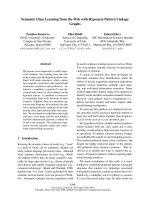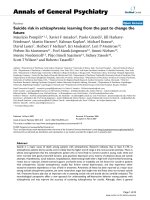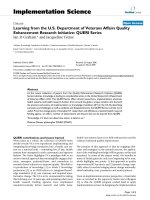Mplementing the learning from
Bạn đang xem bản rút gọn của tài liệu. Xem và tải ngay bản đầy đủ của tài liệu tại đây (446.24 KB, 27 trang )
Implementing the Learning from
Deaths framework: key
requirements for trust boards
July 2017
Contents
Introduction
Purpose
Background
An explanation of key terms
Why focus on engaging bereaved families and carers?
Why focus on case record review and investigation?
New requirements
The trust board’s role
NEDs
Understanding the review process – what questions should NEDs ask?
Championing learning and quality improvement – what questions should NEDs ask?
Assuring published information – what questions should NEDs ask?
Policy publication requirements
Case selection and review method
How the trust responds to the death of particular patients
Selection of deaths to investigate
Engagement with families/carers
NHS Improvement’s role
Medical examiners
Link with mortality rates
Next steps
Resources
3
4
6
7
8
9
12
13
14
15
16
17
18
19
20
21
22
23
24
25
26
Introduction – purpose
This pack is for acute, specialist, mental health and community trust boards and
specifically trust non-executive directors (NEDs) and non-clinical executive directors. It
explains what boards are expected to do in relation to the new Learning from Deaths
framework.
NEDs and non-clinical executives may be less familiar with case record review and
serious incident investigation as means to supporting quality improvement. However,
recent reports from the Care Quality Commission (CQC) and others show that the whole
board must support and encourage these activities to identify areas in need of change
and to inform improvement.
Trust NEDs in particular have been identified as having a critical role to play in holding
their organisations to account for: conducting robust case record reviews and serious
incident investigations; and crucially for implementing effective and sustainable changes
designed to improve safety and wider quality in response.
We explain the requirements of the National Quality Board’s (NQB) new Learning from
Deaths framework, which requires acute, specialist, mental health and community trusts
to adopt a more standardised and transparent approach to learning from the care
provided to patients who die, and what boards need to do to implement this. We also
outline what NHS Improvement will do.
Implementing the Learning from Deaths framework |
3
Introduction – background
CQC published its report Learning, candour
and accountability: A review of the way
NHS trusts review and investigate the
deaths of patients in England in December
2016, making recommendations about how
the approach to learning from deaths could
be standardised across the NHS. The
Secretary of State accepted all these
recommendations and asked NQB to
develop a framework for the NHS on
identifying, reporting, investigating and
learning from deaths in care.
The NHS has a long tradition of learning
from care provided to patients. The
framework builds on that tradition but
recognises that the NHS can do better
particularly in relation to the care of
vulnerable people.
Key findings of the CQC report
• Families and carers are not treated
consistently well when someone
they care about dies.
• There is variation and inconsistency
in the way that trusts become aware
of deaths in their care.
• Trusts are inconsistent in the
approach they use to determine
when to investigate deaths.
• The quality of investigations into
deaths is variable and generally
poor.
• There are no consistent frameworks
that require boards to keep deaths
in their care under review and share
learning from these.
Implementing the Learning from Deaths framework |
4
Introduction – background (contd)
CQC’s recommendations have been
translated into seven national
workstreams.
The Department of Health (DH) has set
up a Learning from Deaths programme
board to support their implementation.
Each workstream is led by the relevant
healthcare body.
The first step in this programme was
the publication of the new Learning
from Deaths framework in March 2015.
In particular this identifies a need to
focus on learning from the care
provided to patients with learning
disabilities and severe mental health
needs who die. Most of these deaths
will occur in acute settings.
Workstreams
1. Delivering a new national Learning from Deaths
framework (DH)
2. Improving how trusts engage with and support
bereaved families/carers (NHS England)
3. Improving learning from deaths of service users with
learning disabilities or serious mental illness (NHS
England)
4. Improving the recording of information about patient
deaths and sharing of this between organisations to
learn from review of the care provided to patients
who die (NHS Digital)
5. Improving the quality and consistency of
investigations into patient deaths (Health and Safety
Investigation Branch – HSIB and Health Education
England – HEE)
6. Supporting trust boards to implement the new
requirements (NHS Improvement)
7. Improving how CQC assesses trusts’ learning from
deaths (CQC)
Implementing the Learning from Deaths framework |
5
An explanation of key terms
Some terms used in the Learning from Deaths framework and in relation to case record review and
investigation can be misunderstood. In this framework the following terms have specific meanings:
Case record review: A structured desktop review of a case record/note carried out by clinicians to
determine whether there were any problems in the care provided to a patient. Case record review is
undertaken routinely in the absence of any particular concerns about care, to learn and improve.
This is because it can help find problems where there is no initial suggestion anything has gone
wrong. It can also be done where concerns exist, such as when the bereaved or staff raise concerns
about care (see also page 8).
Investigation: A systematic analysis of what happened, how it happened and why, usually following
an adverse event when significant concerns exist about the care provided. Investigation draws on
evidence, including physical evidence, witness accounts, organisational policies, procedures,
guidance, good practice and observation, to identify problems in care or service delivery that
preceded an incident and to understand how and why those problems occurred. The process aims
to identify what may need to change in service provision or care delivery to reduce the risk of similar
events in the future. Investigation can be triggered by, and follow, case record review, or may be
initiated without a case record review happening first (see also page 8).
Death due to a problem in care: A death that has been clinically assessed using a recognised
method of case record review, where the reviewers feel the death is more likely than not to have
resulted from problems in care delivery/service provision. Note, this is not a legal term and is not the
same thing as ‘cause of death’. The term ‘avoidable mortality’ should not be used as this has a
specific meaning in public health that is distinct from ‘death due to problems in care’.
Quality improvement: A systematic approach to achieving better patient outcomes and system
performance by using defined change methodologies and strategies to alter provider behaviour,
systems, processes and/or structures.
Implementing the Learning from Deaths framework |
6
Why focus on engaging bereaved
families and carers?
The recent CQC report and other evidence
show that too often the NHS exacerbates the
distress felt by families and carers of patients
who die.
The transformation required in response to
the Learning from Deaths framework is
first and foremost about the way carers
and families are engaged after a death.
Families and carers are unlikely to be greatly
concerned about the minutiae of the
methodology used for case record review or
trust clinical governance structures. People do
highlight the unacceptable way in which they
are sometimes treated, the inconsiderate and
unthinking communications they sometimes
receive, and the lack of information
sometimes provided.
Trusts should:
Provide a clear, honest and sensitive
response to bereavement in a sympathetic
environment
Offer a high standard of bereavement care,
including support, information and guidance
Ensure families and carers know they can
raise concerns and these will be considered
when determining whether or not to review or
investigate a death
Involve families and carers from the start and
throughout any investigation as far as they
want to be
Offer to involve families and carers in learning
and quality improvement as relevant
NHS England is leading work to determine what support bereaved relatives and carers can expect
from trusts (likely to be published early in 2018). Some guidance is already available in the Learning
from Deaths framework and the Serious Incident framework, summarised on page 21.
Implementing the Learning from Deaths framework |
7
Why focus on case record review
and investigation?
Case record review can identify problems with the
quality of care so that common themes and trends
can be seen, which can help focus organisations’
quality improvement work. Review also identifies
good practice that can be spread.
Investigation starts either after case record review
or straight after an incident, where problems in care
that need significant analysis are likely to exist.
Investigation is more in-depth than case record
review as it gathers information from many
additional sources.
The investigation process provides a structure for
considering how and why problems in care occurred
so that actions can be developed that target the
causes and prevent similar incidents from
happening again.
Trusts should focus on how case record review and
investigation lead to effective and sustainable
quality improvement work. Our framework for
leadership and improvement sets out how trusts can
begin to implement their quality improvement
approach.
Data generated from case record review and
investigation, for example estimates of the
number of deaths thought more likely than not
to be due to problems in care, are subjective
and so not useful for making external
judgements about the safety of trusts.
“Case record review assessment is finely
balanced and subject to significant interreviewer variation. It does not support
comparison between organisations and should
not be used to make external judgements
about the quality of care provided.
Research has shown that when case record
review identifies a death that may have been
caused by problems in care, that death tends
to be due to a series of problems, none of
which would be likely to have caused the death
in isolation but which in combination can
contribute to the death of a patient.”
(National guidance on learning from deaths,
March 2017)
Implementing the Learning from Deaths framework |
8
New requirements
The Learning from Deaths framework placed a number of new requirements on trusts:
•
From April 2017 onwards, collect new quarterly information on deaths, reviews, investigations
and resulting quality improvement (see page 10 for the required information).
•
By September 2017, publish an updated policy on how the trust responds to and learns from
the deaths of patients in its care (pages 17 to 21 give more detail on what this policy should
include, as does the Learning from Deaths framework published in March 2017 and other
information available from the NHS Improvement Learning from Deaths website).
•
From Q3 2017 onwards, publish information on deaths, reviews and investigations via a
quarterly agenda item and paper to its public board meetings (see page 10 for the required
information) including information on reviews of the care provided to those with severe mental
health needs or learning disabilities.
•
From June 2018, publish an annual overview of this information in Quality Accounts, including a
more detailed narrative account of the learning from reviews/investigations, actions taken in the
preceding year, an assessment of their impact and actions planned for the next year.
NHS Improvement is fully aware that many organisations, particularly mental health and community
care providers, have less clarity on methodologies and scope for the new requirements. We are
clarifying with national partners and providers what good looks like and we do not expect providers to
have developed perfect processes by Autumn 2017. We will support the system to learn over the
course of the next 12 months.
The main purpose of this initiative is to promote learning and improve how trusts
support and engage with the families and carers of those who die in our care; it is
not to count and classify deaths.
Implementing the Learning from Deaths framework |
9
New requirements (contd)
The Learning from Deaths framework states that
trusts must collect and publish, via quarterly public
board papers, information on:
• number of deaths in their care*
• number of deaths subject to case record review
(desktop review of case notes using a structured
method)
• number of deaths investigated under the Serious
Incident framework (and declared as serious
incidents)
• number of deaths that were reviewed/investigated
and as a result considered more likely than not to
be due to problems in care
• themes and issues identified from review and
investigation (including examples of good practice)
• actions taken in response, actions planned and an
assessment of the impact of actions taken.
Information on deaths should be
published in the quarter after that in
which the death occurred. Where
reviews or investigations are ongoing,
state how many are ongoing and
update this in subsequent publications.
An example dashboard for publication
is available from the NHS Improvement
Learning from Deaths webpage.
The Learning from Deaths framework
requires trusts to collect and publish
information on deaths of both adults
and children (under 18s). Note
however that the child death review
process is distinct (see page 19).
* Trusts can define locally which patients are considered to be ‘in their care’ according to what
makes sense for their services. At a minimum this must include all inpatients but, if possible,
also patients who die within 30 days of discharge from inpatient services. Be aware that this
means all inpatients are in scope for review, not that all inpatient deaths need to be reviewed.
On page 18 we propose which inpatient deaths acute trusts should review.
A simple rule of thumb is that trusts should consider leading the review of the care of a patient if
that trust is the healthcare provider best placed to do so.
Implementing the Learning from Deaths framework |
10
New requirements (contd)
Publication is designed to:
support trusts to learn from each other
ensure transparency and openness as
part of a publicly funded healthcare
system
highlight good and innovative practice
encourage action in relation to identified
problems in care.
Publication is not designed to:
name and shame
support comparison of trusts on the
basis of the number of deaths or the
number of deaths judged likely to be
due to problems in care
encourage blame.
! There is no meaningful measure of ‘avoidable’ mortality at trust level.
! Case record reviews involve finely balanced judgements. Different reviewers may have different
opinions about whether problems in care caused a death. That is why this data in not comparable.
! Case record reviews and Serious Incident investigations are not inquiries into how people died –
that is a matter for coroners. Criminal investigations are a matter for the police.
! Any publication that seeks to compare organisations on the basis of the number of deaths thought
likely to be due to problems in care is actively and recklessly misleading its readers.
In the period leading up to publication, NHS Improvement will develop further support resources for
providers that will help them to help the public understand this data.
Implementing the Learning from Deaths framework |
11
The trust board’s role
Boards are responsible for the quality of the healthcare their trusts provide, including its
safety. The Learning from Deaths framework places particular responsibilities on boards,
as well as reminding boards of their existing duties.
Board responsibilities
• Ensuring their trust has robust systems for
recognising, reporting and reviewing or
investigating deaths where appropriate.
• Ensuring their trust learns from problems in
healthcare identified by reviews or investigations
as part of a wider process that links different
sources of information to provide a
comprehensive picture of their care.
• In this context ‘learning’ means taking effective,
sustainable action (via appropriately resourced
quality improvement work) to address key
issues associated with problems in care.
• Providing visible and effective leadership to
support their staff to improve what they do.
• Ensuring the needs and views of patients and
the public are central to how the trust operates.
Boards should ensure the case record
review process sits within their wider
clinical governance processes:
• incident reporting and response
• risk management
• clinical audit
• staff management
• patient and public involvement
• research and development
• education and training
• clinical effectiveness
• information management.
Evidence shows that deaths caused by
problems in care will occur in every single NHS
trust and every hospital worldwide. The key is
to learn from them as part of well-functioning
clinical governance processes.
Implementing the Learning from Deaths framework |
12
The trust board’s role – NEDs
NEDs play a crucial role in bringing an independent perspective to the boardroom,
constructively challenging the executives to satisfy themselves that clinical quality
controls and risk management systems are robust and defensible.
The Learning from Deaths framework requires each
trust’s board to identify a NED to oversee the trust’s
approach to Learning from Deaths.
NEDs need to be curious about their organisation's
approach to the delivery of healthcare and constructively
challenge their trust to identify where care can be
improved, then support that improvement. Evidence
shows that adverse events are usually due to
weaknesses in systems rather than the fault of
individuals. Blame is therefore not a useful approach.
Within this role, NEDs have an opportunity to model the
behaviour within high reliability organisations, which treat
problems as an opportunity to genuinely learn and
encourage ‘problem sensing’ not ‘assurance seeking’
among teams and organisation-wide.
NED responsibilities in relation
to the framework
• Understand the review process:
ensure the processes for reviewing
and learning from deaths are
robust and can withstand external
scrutiny.
• Champion quality improvement
that leads to actions that improve
patient safety.
• Assure published information:
that it fairly and accurately reflects
the organisation's approach,
achievements and challenges.
The following pages give more detail
on these responsibilities.
Implementing the Learning from Deaths framework |
13
Understanding the review process –
what questions should NEDs ask?
•
•
•
•
•
•
•
•
•
•
•
•
•
•
•
•
•
How is the case record review process carried out?
How are cases selected for case record review (see advice for acute hospitals on page18)?
What is the quality of data collected by the trust and what are its limitations?
Are those reviewing cases trained to do so according to a robust method such as PRISM or
structured judgement review?
Is the LeDeR method used to review deaths of people with learning disabilities?
How are deaths of those with severe mental illness reviewed (see page 19)?
How are perinatal and maternal deaths reviewed (see page 19)?
How are infant and child deaths reviewed (see page 19)?
Is there multidisciplinary review of cases?
Is there objective review of cases – wherever possible not carried out by those involved in the
care of the patient who died?
Are there arrangements for periodic review of the trust’s processes and findings by peer trusts?
Are families/carers given the opportunity to request a review?
Are all cases where problems with care are thought likely to have led to the death investigated in
line with the best practice outlined in the Serious Incident framework?
Are all families and carers engaged properly where problems are found?
Are all families and carers involved in investigations from the start, and kept informed of
subsequent improvement work if they wish to be?
How is case record review data triangulated with other quality data collected outside the review?
What does the data say about what drives mortality in the trust?
Implementing the Learning from Deaths framework |
14
Championing learning and quality
improvement – what questions
should NEDs ask?
•
•
•
•
•
•
•
•
•
•
What are the trust’s most significant problems? Where should quality improvement be prioritised?
What is the organisation’s strategy for improving the quality of the care it provides?
What approach and method(s) does it use?
How well is quality improvement work resourced?
How does the trust use Learning from Deaths, Serious Incidents and other patient safety-related
events to inform quality improvement work? Is good practice identified as well as problems?
Who is the board executive lead and how well sighted is the board on this work?
How are the necessary changes in clinical practice supported and enabled?
How are the wider themes and trends from case record reviews or investigations shared across
the organisation and with any others that may have an interest? Are these processes effective?
How are patients, families and carers involved in quality improvement and sharing learning?
What changes have been made as a result of this work? Has quality of care improved as a
result? How do you know?
Changing trust policies, training staff and reminding them how something should be done are all
relatively weak barriers to error. NEDs should consider how their trust avoids resorting to these
weak, simplistic barriers to risk wherever possible and instead invests in more effective and
sustainable changes to practice, underpinned by human factor approaches, systems thinking and
quality improvement techniques.
Implementing the Learning from Deaths framework |
15
Assuring published information –
what questions should NEDs ask?
• Do I understand the information we publish? Do I know how many deaths occur and where, and
what problems are associated with them?
• What is not shown by the data? Are there gaps/incomplete information?
• Is the information published in board papers:
o easy to understand and interpret
o accurate
o timely
o proportionate?
• Does the information identify improvement needs and how these could be met?
• Does the information reveal how previous information was acted on and what has changed as a
result? Sharing both successful and unsuccessful quality improvement work is important.
• Does the information clearly describe how the trust uses Learning from Deaths, Serious Incidents
and other patient safety-related events to inform quality improvement work?
• How well sighted is the board on this published work?
• How are arrangements for gathering stakeholder feedback in response to published information
working?
• Does the information demonstrate that the trust has done what it said it would do?
Implementing the Learning from Deaths framework |
16
Policy publication requirements
By the end of September 2017, trusts should publish on their website an updated
policy on how they respond to and learn from the deaths of patients in their care.
The policy should include:
The trust’s case
record review
process, including
the method used,
how the scope of
deaths for potential
review is
determined and
how deaths are
selected for review.
How the trust
responds to the
death of someone
with a learning
disability or severe
mental health
needs, of an infant
or child, or a
stillbirth or
maternal death.
How the trust
decides which
deaths – whether
reviewed or not –
require an
investigation under
the Serious Incident
framework.
How the trust
engages with
bereaved families
and carers,
including how they
are supported by
the trust and
involved in
investigations
where relevant.
The policy should set out what trusts are doing currently. It should reflect the requirements of the
Learning from Deaths framework and related policies (for example, the Serious Incident framework).
NHS Improvement will not routinely assess the content of published trust policies or collate those
policies. Publication is designed to support openness and transparency and enable peer learning.
Implementing the Learning from Deaths framework |
17
Policy publication requirements –
case selection and review method
A trust’s published policy should include the case review method used, how it decides which deaths are in scope
for potential review and how it selects the cases for review.
Trusts can use any relevant evidence-based case record review method (see page 19 for requirements for certain
specific patient categories), but the chosen method must collect the required information (see page 10). Options
include structured judgement review (SJR; training and documentation is available from the Royal College of
Physicians – note this is adult inpatient specific) and the PRISM method. We encourage trusts to avoid tickbox/checklist review tools if possible as these only assess the issues listed, missing those not directly assessed,
and do not consider the right care for a specific patient (they consider the right care for a ‘typical’ patient).
Acute trusts: The Independent Advisory Group to RCP’s national mortality case record review programme
recommends that all inpatient deaths in the following categories are reviewed:
• deaths where the bereaved or staff raise significant concerns about the care
• deaths of those with learning disabilities or severe mental illness
• deaths in a specialty, diagnosis or treatment group where an ‘alarm’ has been raised (for example, an
elevated mortality rate, concerns from audit, CQC concerns)
• deaths where the patient was not expected to die ̶ for example, in elective procedures
• deaths where learning will inform the provider’s quality improvement work.
A sample of other deaths should be reviewed to clarify where learning and improvement are needed most. If
possible, patients who die within 30 days of discharge from inpatient services should be considered in scope for
potential review.
Mental health and community trusts: Taking a proportionate approach, trusts should develop and publish a
rationale for the categories of outpatient/community patient considered in scope. It is assumed all inpatient
deaths will be reviewed.
Implementing the Learning from Deaths framework |
18
Policy publication requirements –
how the trust responds to the death
of particular patients
A trust’s published policy should include how the trust examines the care provided to specific types of
patients as outlined below:
Learning disability
Trusts must have systems to flag patients with learning disabilities.
Once available in their area, trusts should adopt the LeDeR method
for reviewing the deaths of people with learning disabilities. For
guidance on reviewing deaths see: />media-library/sites/sps/leder/Guidance%20for%20the
%20conduct%20of%20reviews%20%20FINALv2.2.pdf
Trusts should also conduct an initial case note review of all deaths of
people with learning disabilities using SJR or another robust and
evidence-based methodology. This ensures that there is appropriate
clinical review of the last episode of care.
Perinatal or maternal death
All perinatal deaths should be reviewed, using the new
perinatal mortality review tool once available. Maternal
deaths and many perinatal deaths are very likely to meet
the definition of a Serious Incident and should be
investigated accordingly.
Severe mental health needs
Trusts must have systems that flag those with
severe mental health needs so that their care can
be reviewed. NHS England is co-ordinating work to
develop a mental health review method. Acute trusts
can use SJR or another relevant method to review
the acute care of those with severe mental health
needs who die in an acute hospital.
Infant or child (under 18) death
Reviews of these deaths are mandatory and must
be undertaken in accordance with Working
together to safeguard children . The Department
for Education Form C should be used for these
deaths. New child death review guidance is being
developed and will be published by the end of
2017.
Implementing the Learning from Deaths framework |
19
Policy publication requirements –
selection of deaths to investigate
A trust’s published policy should include how it determines which deaths should be investigated under
the Serious Incident framework.
This framework defines what constitutes a
Serious Incident. These are so designated
because the consequences of the adverse
event are so significant to patients, families
and carers, staff or organisations, or the
potential for learning is so great that a
heightened level of response is required.
The required response is an effective
investigation involving patients, families and
others to the extent they wish to be, focused
on learning why things went wrong and
identifying effective and sustainable changes
to reduce the risk of recurrence.
Serious incident investigations are not
undertaken:
Trusts should describe how they:
• decide which deaths are declared and
investigated as Serious Incidents
• keep an audit trail of these decisions.
Deciding whether an incident should be declared
a Serious Incident or not can require finely
balanced judgement, taking account of the costs
and benefits of investigation. This means there
can well be a range of opinions about whether a
particular death constitutes a Serious Incident.
But the way in which the decision is reached to
declare a Serious Incident should always be
clear and defensible.
• to hold individuals or organisations to
account
• to determine the cause of death.
Implementing the Learning from Deaths framework |
20









